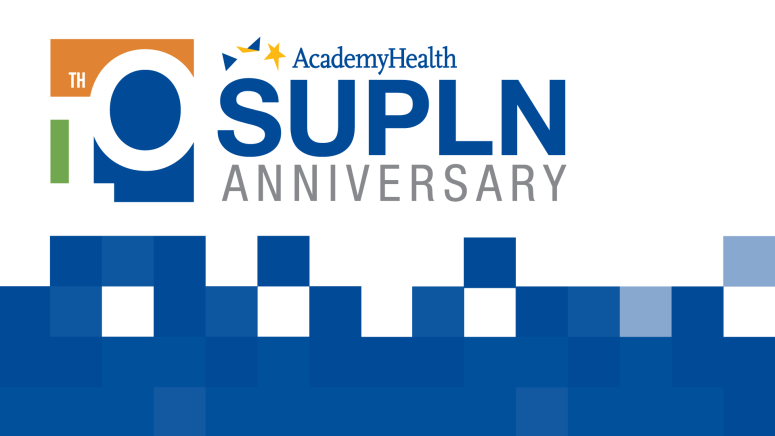
The value propositions for Medicaid agencies and public universities make a strong case for state agency-university partnerships, but another important relationship to consider is the partnership between university leadership and the research center that performs policy research and data analytics for the state Medicaid agency. As outlined in this series’ inaugural blog, the role, governance, organizational structure, and staffing of research centers in the AcademyHealth State-University Partnership Learning Network (SUPLN) vary; however, a center’s effectiveness depends on a mutually beneficial relationship not only with the partnering state agency, but also with the university administration and faculty.
This year, the Maryland Department of Health and The Hilltop Institute at UMBC celebrate a partnership spanning 30 years. The support of UMBC has been integral to the success of this enduring collaboration. However, university relations can pose challenges for a research center whose work differs from traditional faculty-led research and focuses on informing state health policy and addressing the needs of a state agency. Below are my reflections on partnership building within the university community based on lessons learned during my 11 years at the helm of The Hilltop Institute.
Mission Matters
First and foremost, the research center’s mission must clearly align with the university’s mission and strategic priorities. Public universities typically cite public service among the traditional missions of education and research. Through a strategic planning process, research centers should develop, periodically update, and publish a mission statement consistent with the university’s mission, articulating the center’s vision for contributing to education, research, and public service. Active participation in university strategic planning and priority setting will also demonstrate the center’s commitment to upholding the university’s mission.
Uphold a Commitment to Unbiased Research
Losing sight of objectivity and falling prey to partisanship can irreparably damage the center’s reputation within the university and beyond. It is imperative that all research and policy analysis be fact-based and data-driven; it should rise to the highest levels of accountability and transparency.
Demonstrate the Value of Engaged Scholarship
Some in academe question whether policy research and data analytics performed for a state agency is “real” research. Centers should proactively prioritize engaged scholarship and communicate its value to the broader university community. Defined as “a participative form of research for obtaining the advice and perspectives of key stakeholders … to understand a complex social problem,” engaged scholarship aims to bridge theory and practice. Scholars who advocate for this research method argue that “engaged scholarship produces knowledge that is more penetrating and insightful than when scholars or practitioners work on the problems alone.” For research centers, this means simultaneously formulating and investigating research questions while collaborating with the state agency to address a real-world problem, publishing research findings, and using findings in a continuous cycle of policy and program improvement.
Engage Students in Experiential Learning
Research centers are an ideal laboratory for experiential learning. Public universities are charged with training the state’s future workforce, and research centers can play a central role in training both undergraduate and graduate students. Centers offer students a unique opportunity to work with authentic large data sets, apply data analysis to real-world problems, and benefit from hands-on guidance by experienced researchers and data scientists who understand both analytic methods and state health policy. Moreover, centers can provide valuable cross-disciplinary training—e.g., guiding STEM majors on how to structure data inquiries that effectively address policy issues; training budding social scientists to sharpen their analytic skills.
Build and Nurture Faculty Relationships
Research centers affiliated with SUPLN follow varying governance and organizational models, ranging from faculty-led centers embedded in an academic department to semi-autonomous centers not affiliated with a department and composed of university staff, not faculty (the latter is Hilltop’s model). Whatever the model, paramount to success is cultivating a "champion” within university leadership to advocate for the center. In addition, relationship building with faculty from across the campus will foster cross-disciplinary research, research collaborations, and creative strategies for cross-departmental student engagement and experiential learning. Faculty will in turn glean a better understanding of the center’s work and its contributions to both the university and the state.
Partner to Leverage and Advance University Resources
This can be a win-win for both the center and the university. For example, many research centers maintain repositories of protected health information on behalf of state agencies. A partnership with the university’s information technology (IT) division can offer support for the center’s IT infrastructure as well as opportunities to adopt state-of-the-art technologies that can be a model for the campus. At the same time, the partnership can assure university leadership that the research center complies with data privacy and security laws and regulations.
Communicate the Research Center’s Impact
It is important to continuously educate the broader campus community about the research center’s aligned mission and research, contributions to the university, and impact on state health policy. Newsletters, press releases, annual reports, campus roundtables, and meetings with faculty and university leadership can be effective vehicles. Metrics should be included to highlight the research center’s impact.
Heeding these pointers will help to ensure a research center’s effectiveness, longevity, and acceptance as a meaningful contributor to the university’s mission and strategic priorities.